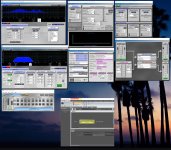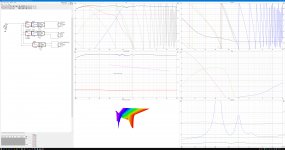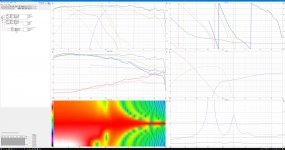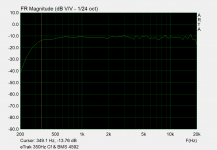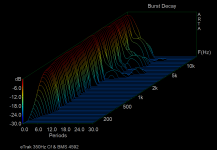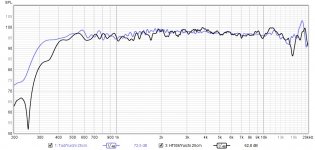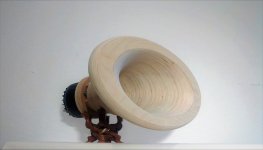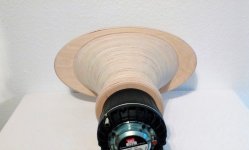The more simulations I run the more I find myself coming to the conclusion that Earl Geddes was right again
I see this a lot. It's probably why I take to heart what he said with regard to the importance of frequency ranges:
I view sound system design in three major frequency ranges - low frequencies, where modal effects and the room dominates, there is no imaging or psychoacoustics to worry about, its simply a matter of adequite output and smooth spatial and frequency response (more on this in another thread); 200 Hz - 1000 Hz, probably the most forgiving of the three regions, our auditory system is only just begining to be capable of resolving spatial aspects (localization) and it is not yet very good at resolution of time delays, reflections and frequency response. If you are going to compromise something do it here as it will have the least noticable effect. Above 1 kHz is where we live as far as music is concerned. This region is ultra sensitive to time delays, reflections, frequency response, diffraction, all the things that tend to mess up coloration and imaging. Mess up this frequency region and you won't be able to recover the sound quality. Here is not where you want to make compromises for sound quality. - Geddes
Which I think has a lot of relevance to a two-way. It confuses me why a DIYer would want a 15" woofer in their main channels. It makes sense to me to do it if you're trying to sell a speaker to the public because an audiophile customer will be put off if your speaker marketing doesn't say, "this one goes to eleven."
As DIYers we aren't selling our products to customers. So why are we building mains that play into the modal region?
In the context of this thread I'd say, "Is it possible to cover 200Hz to 10,000Hz (assuming 60 year old ears) with a 2-way?"
Lol! To be taken with a grain of salt.
That video shows what the average person could do...but doesn't....I've made my own hepa flow hood before...putting a hepa filter in front of a box fan will in fact screen the air no less than any other air scrubber claiming hepa that you might buy at walmart.
HEPA is too restrictive. A box fan can't create the pressure it needs. You need to use a MERV 13 or less, 13 is pushing it. You will also be better off with a deep filter like a 4 inch as you go higher in MERV rating because it will be easier for the box fan to push air through it.
I have a Foobot air quality sensor that measures air particulates in the house. The DIY box fan does an amazing job knocking down the numbers. But it has to run all the time.
Also, the Foobot goes bonkers when we cook. Compared to cooking a speaker shedding rockwool or fiberglass is nothing. Maybe I'd worry about it if I was building a speaker for a surgery or clean room.
Which I think has a lot of relevance to a two-way. It confuses me why a DIYer would want a 15" woofer in their main channels. It makes sense to me to do it if you're trying to sell a speaker to the public because an audiophile customer will be put off if your speaker marketing doesn't say, "this one goes to eleven."
I used a 15" in my premium loudspeaker and it does not go very low because the box is sealed. So I am not using it for a lower LF spec. I used a 15 because it has a higher DI at the crossover and allows for the whole system to have a higher DI. The high output potential is just an added benefit.
I would not want to take two 15s all the up to the crossover because they would get so narrow vertically. Better is two blend in one slowly below the Xover (ala JBL 2440?). That way you can approach a flatter DI than a single driver can do.
Then multiple spaced subs, of course.
Then multiple spaced subs, of course.
Better is two blend in one slowly below the Xover
200 Hz - 1000 Hz, probably the most forgiving of the three regions
I really wanted to make two redundant large woofers work, under the tops...in order to keep the polar wide I seem to have landed in a position like Geddes describes. I also had a similar thought about ear sensitivity and where xovers are placed...It made sense to not break up the vocal range if possible and it made sense to have the compromises be below the Schroeder freq.....originally my xover goal was as low , like 200hz, if anyone remembers. 350hz is not bad tuning I have support from other wise hears that 350hz is the biggest I should entertain for a "top".... Larger horns, in my opinion, have to share some type of likening to a large transmission line, where as the resonate tail becomes longer and louder....I predict that with larger horns it becomes even more important to stay away from Fc.If you are going to compromise something do it here as it will have the least noticable effect.
Attachments
Last edited:
I do have some with that data in it but its still inaccurate uptop...I didn't know how to exactly model a horn in the VCab
This is some horn I tried to model in Vcab combined with the response shown in the Celestion specs on a Seos 30....the 15m is crossed higher in this iteration.
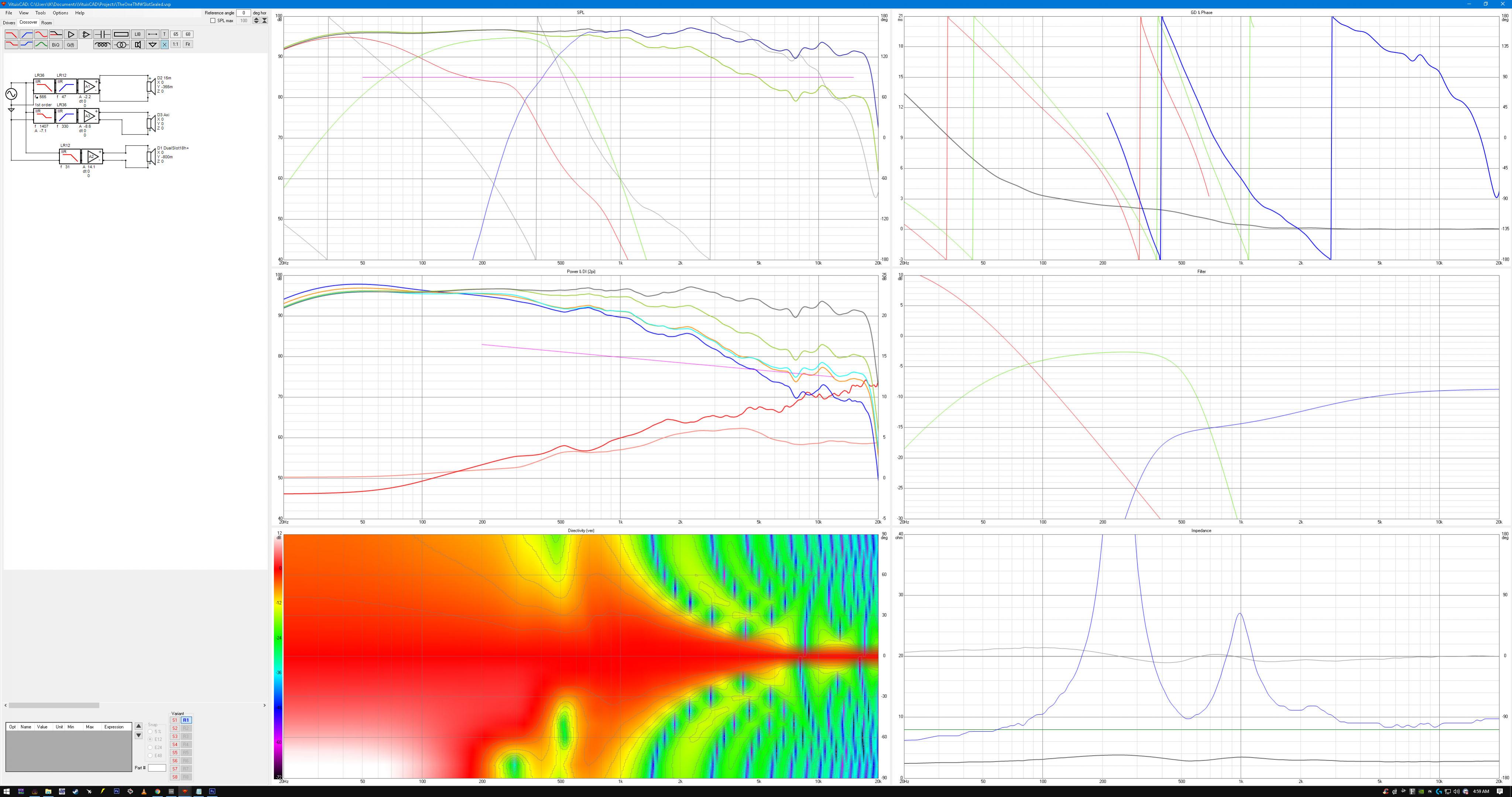
This is some horn I tried to model in Vcab combined with the response shown in the Celestion specs on a Seos 30....the 15m is crossed higher in this iteration.
Attachments
Last edited:
That certainly looks more realistic but not ideal. Vituix can do a pretty good job of simulating directivity based on piston size and diffraction from the size and shape of the baffle. That should work well enough for the woofers.
Creating off-axis responses with VituixCAD Diffraction tool - YouTube
For the horn you would need a real measurement or a fairly detailed BEM simulation.
Creating off-axis responses with VituixCAD Diffraction tool - YouTube
For the horn you would need a real measurement or a fairly detailed BEM simulation.
autotech publishes directivity for at least some of the SEOS family.
I was able to use Vituix SPL trace to tool to import SEOS 18 directivity into Vituix. Its difficult to trace perfectly near the axis where the adjacent angles sometimes overlay but persistence pays off and the result is still better than not having any directivity information in the sim
I was able to use Vituix SPL trace to tool to import SEOS 18 directivity into Vituix. Its difficult to trace perfectly near the axis where the adjacent angles sometimes overlay but persistence pays off and the result is still better than not having any directivity information in the sim
I don't follow that procedure exactly. Instead of using the response produced by the enclosure tool, I trace the on axis response from the data sheet using the trace too. This is closer to using a measurement. The differences between the data sheet SPL and enclosure tool SPL are either due to box size and easily equalized away or due to the real driver's characteristics - like cone breakup effects beyond cutoff, which do have a 2nd order effect on the system response.
Anyone know how to model an elliptical tractrix....I could at least get the horn and midrange into Akabak....I'm not sure if I can use Akabak for my subwoofer because it is PPSL.
Maybe something here ? Tools – Volvotreter Homepage
Gedlee,
Do you know good metric for enclosure material/structure evaluation? See:
Which Is Better for Sound? - YouTube
Do you know good metric for enclosure material/structure evaluation? See:
Which Is Better for Sound? - YouTube
Did you see this? "Shadow of The Colossus" build thread
No I didn't and thank you for thinking of me...
BMS and my Horn
Measurements from the "Shadow of The Colossus" build thread
Spectral of my horn and BMS
This spectral and Fr I received from the horn maker, I'm not certain all the details but the spectral confuses me, there is no resonate tail...what type measurement is that?
Because I am not smart enough to model it myself nor does the horn maker have a chart for me...I stare at this and imagine......
I've shared some these charts before...
on axis with just the hf of the BMS
25 degrees Horizontal
Attachments
Last edited:
Gedlee,
Do you know good metric for enclosure material/structure evaluation? See:
Which Is Better for Sound? - YouTube
The stiffness and internal damping. But the stiffness of the end result is dominated by the construction. Damping is also heavily influence by construction so the material properties are significant but not dominate.
Lousy. You need a 3 way.
You may haven't heard a good two way system at all.
My mid/high horn driver combination goes right from 500 Hz to 16Khz. If you think thats not enough, go straight to a medical doctor for a test, my hearing ability ends way below and what matters in music is located in the middle, not in a 22Khz super trebble tweeter.
P.S. The best woofers I have heard were 18 inch. Fast, ultra expensive and transparent, very high SPL.
- Home
- Loudspeakers
- Multi-Way
- Is it possible to cover the whole spectrum, high SPL, low distortion with a 2-way?

